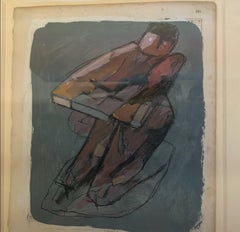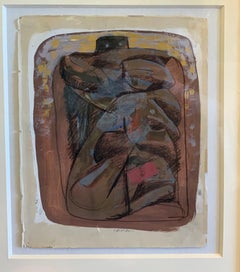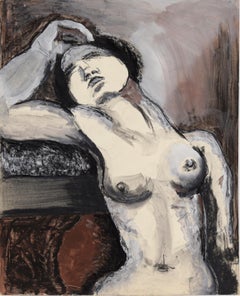George Nama Paintings
American, b. 1939
George Nama (b. 1939 - ) is an American artist. Nama claims that all his images, whether drawings, etchings or sculptures, are figurative. If they don’t show something that really exists, his configurations “might exist”. Nama’s city of his birth, Homestead, Pennsylvania played a major role in his artistic vocabulary and imagery created in the early 1960’s. Industrial and rugged and largely void of color, Nama recreated familiar city vistas in a rich palette of blacks and grays. Using casein paint, oil sticks, watercolors and inks Nama also masterfully reproduced interiors of his mother’s living room, and his grandmother’s kitchen. Some of the later works, his openly expressionistic sketches of trees, fast and precise, figures and country landscapes point to his transition towards abstraction. Already involved with poets and writers since the early 1960s, Nama collaborated in 1976 with his friend, the French poet and art historian Yves Bonnefoy, on artist’s books. This in turn fostered a series of artist’s books and exhibitions with Alfred Brendel and Charles Simic. During his long career, Nama has been represented in numerous important exhibitions, galleries, and public collections, such as The Morgan Library, the Boston Athenæum, The Metropolitan Museum, the Brooklyn Museum and the Carnegie Institute. He was recently included in the distinguished international art fairs at Maastricht and the Salon du Dessin in Paris.to
2
2
Overall Width
to
Overall Height
to
2
2
2
2
2
2
2
17
781
712
709
689
2
Artist: George Nama
Untitled
By George Nama
Located in Santa Monica, CA
Gouache and charcoal on antique music paper
Category
2010s Contemporary George Nama Paintings
Materials
Charcoal, Gouache
$900 Sale Price
25% Off
Untitled
By George Nama
Located in Santa Monica, CA
Gouache and charcoal on antique music paper
Category
21st Century and Contemporary Contemporary George Nama Paintings
Materials
Charcoal, Gouache
$900 Sale Price
25% Off
Related Items
Original-Meeting Van Gogh-Study Master Series-British Awarded Artist-Ink Drawing
Located in London, GB
This drawing studied of Van Gogh's self-portrait at his Solo exhibition " Poets and Lovers" in National Gallery, London, 2024.
Shizico Yi learned her craft in drawings from old mast...
Category
2010s Contemporary George Nama Paintings
Materials
Ink, Archival Paper, Charcoal, Gouache, Acrylic
$518
H 8.27 in W 11.7 in D 0.08 in
Black and White Nude Woman in Acrylic, Gouache, and Charcoal on Paper
Located in Soquel, CA
Black and White Nude Woman in Acrylic, Gouache, and Charcoal on Paper
Black and white painting of a woman by acclaimed bluegrass musician Katherine ...
Category
1970s Contemporary George Nama Paintings
Materials
Paper, Charcoal, Acrylic, Gouache
$1,320 Sale Price
20% Off
H 28.38 in W 22.5 in D 0.02 in
Nude Woman on Striped Chair #2 in Charcoal and Gouache on Paper
Located in Soquel, CA
Nude Woman on Striped Chair #2 in Charcoal and Gouache on Paper
Black and white painting of a woman by acclaimed bluegrass musician Katherine "Kathy" Kallick (American, b. 1952). Th...
Category
1970s Contemporary George Nama Paintings
Materials
Paper, Charcoal, Gouache
$950
H 19 in W 14 in D 0.02 in
Futurist Vision - Mid-Century New York Skyline - Industrial Progress
Located in Miami, FL
Rarely do you come across a work of art that is vastly different than just about anything you see. This work is undeniably brilliant and a sheer pleasure to behold. Alexander Leydenfrost...
Category
1950s Art Deco George Nama Paintings
Materials
Gouache, Board, Graphite, Charcoal
$50,000
H 25.5 in W 30.5 in
Float (Whimsical Landscape Collage of Swans and Figure Against Blue Sky)
Located in Hudson, NY
Float (Whimsical Landscape Collage of Swans and Figure Against Blue Sky) by Olan Quattro
2024, gouache, paper, and acrylic on wood panel, 24 x 36 inches
Olan Quattro's subtle and so...
Category
2010s Contemporary George Nama Paintings
Materials
Paper, Acrylic, Gouache, Wood Panel
$2,900
H 24 in W 36 in D 1 in
Bauhaus Moshe Raviv Moi Ver Abstract Dancing Painting Lithuanian Israeli Modern
Located in Surfside, FL
Dancing Jesters or Clowns (colorful Chassidim dancing)
Gouache on paper
Sheet is 19.25 X 25.25
Image is 13.5 X 19.25
Moshé Raviv-Vorobeichic, known as Moi Ver, born Moses Vorobeichik (1904–1995) was an Israeli photographer and painter.
Moi Ver (Moshe Raviv) was born in 1904 in Vilnius, Lithuania as Moshe Vorobeichic.
Moshe Vorobeichic received his initial artistic training in the early 1920s in Vilnius, Lithuania, where he studied painting, architecture, and photography. Having become an important figure in the Yiddish avant-garde culture, he exhibited his first works. From October 1927, he studied at the Bauhaus school in Dessau (Germany), with photographer-visual artist Laszlo Moholy Nagy and painters Josef Albers, Paul Klee, Wassily Kandinsky, and Hinnerk Scheper.
In his book Moi Ver: Paris, he produced avant-garde photomontages. Originally published in 1931 by Editions Jeanne Walter with an introduction by futurist Fernand Leger.
In 1932 Raviv was sent by the weekly La Vie Parisienne to British Mandate Palestine as photo reporter. Raviv illustrated many books. Raviv was a founder of the Artists' Colony in Safed.
At the height of 20th Century modernism and one of the followers of Laszlo Moholy Nagy and his concept of New Vision, Moin Ver was one of the rising stars in European photography. Born in Lebedeva, in Belarus, he wandered through Europe until he immigrated to Palestine in 1934. His well known yet partly forgotten three photographic projects in 1931, The Ghetto Lane in Wilna, Paris: 80 Photographies de Moi Ver and Ci-Contre – 110 Photos de Moi Ver (that was not published at the time), have remained milestones in the art of the 1930s as he created and imposed a new visionary style in photography.
As a contemporary of artists such as Man Ray, Ilse Bing...
Category
20th Century Bauhaus George Nama Paintings
Materials
Paper, Gouache
The Haveli-2, Gouache & Gold Leaf on Handmade Paper by Indian Artist "In Stock"
By Yugal Kishor Sharma
Located in Kolkata, West Bengal
Yugal Kishor Sharma - The Haveli-1
15 x 15 inches (unframed size)
Gouache & Gold Leaf on Handmade Paper.
(Unframed & Delivered)
Yugal Kishore Sharma The Haveli-1 Gouache & Go...
Category
2010s Contemporary George Nama Paintings
Materials
Gold Leaf
$1,430
H 15 in W 15 in D 1 in
Same Old Story (Brooklyn Dodgers & St. Louis Cardinals Illustration)
Located in Wilton Manors, FL
Bill Crawford (1913-1982). Original illustration artwork depicting teams as they advance to the World Series. Depicted are representations of the St. Louis Cardinals and The Brooklyn...
Category
1940s Realist George Nama Paintings
Materials
Paper, Charcoal, Ink, Gouache, Pencil
$1,200
H 29 in W 21.5 in D 0.5 in
10 Maneras de Volar 10 - Abstract Latin American Gouache on Paper, 2010
By Carlos Luna
Located in Palm Desert, CA
10 Maneras de Volar 10 is a gouache and charcoal on Amate paper by Latin American artist Carlos Luna. Executed in black, brown, deep blue, red and white, the work depicts a flying, p...
Category
21st Century and Contemporary Contemporary George Nama Paintings
Materials
Charcoal, Gouache, Paper
$10,000
H 19 in W 27 in
Mid Century Figurative Painting Purple, Orange, Gray, Yellow Pastel and Paint
By Gloria Dudfield
Located in Arp, TX
Gloria Dudfield (1922-2015)
Untitled
c.1960s
Mixed media: gouache, pastel and encaustic on newsprint
12"x19.5" paper cut unevenly, unframed
Unsigned
Gloria (Fischer) Dudfield
July 1...
Category
Mid-20th Century Abstract George Nama Paintings
Materials
Paper, Pastel, Encaustic, Gouache
Italian Pop Art Mixed Media Surrealist Painting Collage Gouache Emilio Tadini
By Emilio Tadini
Located in Surfside, FL
Emilio Tadini (1927-2002)
Original Collage, Gouache and Watercolor painting.
Dimensions: 41 X 29.5. framed. 39.75 X 28 artwork
Emilio Tadini (1927 – 2002 ) was an Italian painter,...
Category
20th Century Surrealist George Nama Paintings
Materials
Paint, Paper, Mixed Media, Watercolor, Gouache
$5,500
H 41 in W 29.5 in
American Female Abstract painter Modernist Still Life w/ Fruits GALLERY LABEL
By Peri Schwartz
Located in New York, NY
Peri Schwartz (born October 4, 1951, Brooklyn, New York) is an American painter and printmaker. She was born in Brooklyn, New York and raised in Far Rockaway, New York. She received her BFA from Boston University College of Fine Arts in 1973 and an MFA from Queens College in 1975.
Up for sale is a wonderful Still Life with fruits Painting...
Category
1990s Abstract Expressionist George Nama Paintings
Materials
Charcoal, Pastel, Mixed Media, Gouache
$5,200
H 33 in W 38 in D 2 in
George Nama paintings for sale on 1stDibs.
Find a wide variety of authentic George Nama paintings available for sale on 1stDibs. You can also browse by medium to find art by George Nama in charcoal, gouache, paint and more. Much of the original work by this artist or collective was created during the 21st century and contemporary and is mostly associated with the contemporary style. Not every interior allows for large George Nama paintings, so small editions measuring 10 inches across are available. Customers who are interested in this artist might also find the work of TF Dutchman, Kerry Smith, and Joshua Goode. George Nama paintings prices can differ depending upon medium, time period and other attributes. On 1stDibs, the price for these items starts at $900 and tops out at $900, while the average work can sell for $900.


